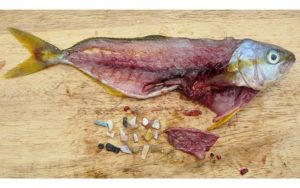
Tiny bits of plastic have seeped into soil, fish and air, posing a threat to animal and human health.
Mark Browne had a suspicion. He hoped the samples of dried blood taken from a blue mussel and placed under a special microscope would tell him if he was correct. As a fuzzy, three-dimensional image of the mussel’s blood cells appeared, there they were, right in the middle—tiny specks of plastic.
Whereas photos of sea turtles eating plastic bags have become the poster child of the environmental harm wrought by humanity’s plastic waste, research like Browne’s illustrates the scope of the problem is far larger than the trash we can see. Tiny pieces of degraded plastic, synthetic fibers and plastic beads, collectively called microplastics, have turned up in every corner of the planet—from Florida beach sands to Arctic sea ice, from farm fields to urban air.
BY Andrea Thompson